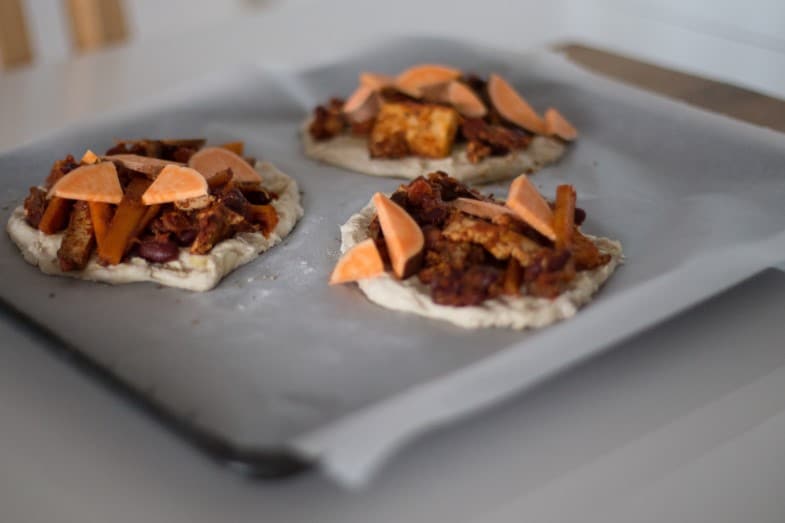If one of your hobbies includes baking and grilling, then you probably have used aluminum foil many times. But can you really put aluminum foil in the oven? Is it safe?
Can you put aluminum foil in the oven? Yes, it is safe to use aluminum foil in the oven, even at very high oven temperatures. The melting temperature of aluminum foil at standard pressure is 1,220 degrees Fahrenheit (660 degrees Celsius). Most home ovens cannot exceed 500 degrees Fahrenheit (260 degrees Celsius), so the foil will not catch melt or catch fire in your home oven.
There are instances in which aluminum foil is recommended, and in some cases, it is not. Read on to learn more about aluminum foil and how to use it in your oven.
What Is Aluminum Foil?
First, aluminum foil is not the same as tinfoil. Tinfoil, as the name suggests, is a foil mainly made of tin. On the other hand, aluminum foil is from aluminum metal with a thickness of approximately 0.2 mm (7.9 mils) and 6 micrometers (0.24 mils).
According to Wikipedia, the standard household foil usually has a thickness of about 0.016 mm (0.63 mils), while heavy-duty foil has a thickness of about 0.024 mm (0.94 mils). [1] To enhance the properties of the foil, they are usually laminated using plastic or paper.
Due to its pliability, aluminum foil has become a common household item used in wrapping things, such as food when baking or grilling, particularly when cooking fish, mushrooms, and vegetables to prevent them from losing moisture. But most commonly, aluminum foil is used to line baking pans or trays, so they will be easier to clean after cooking.
Aside from cooking and baking, aluminum foil has many other uses, such as packing, transportation, insulation, and even art and decoration.
Aluminum occurs naturally on the Earth’s surface, such as in silicates, cryolite, and bauxite rock. This metal is also present in water as aluminum sulfate, which acts as a coagulant to purify water. It is also present in utensils and containers, herbs, tea leaves, spices, yellow cheese, antacids, antiperspirants, and corn, among others.
Can You Put Aluminum Foil in the Oven?
Although we have already established earlier that you can put aluminum foil in the oven, let me answer this question more accurately by listing below some of its common uses.

Aluminum Foil in Oven Common Uses
1. As Lining Over the Oven Rack
One frequent question by many is, “Can you put aluminum foil directly on the oven rack?”
Some food enthusiasts use oven racks lined with heavy-duty aluminum foil as a substitute for baking or cookie sheets. With this method, the oven rack is the one serving as the support structure. In this case, the main purpose of using foil is to prevent the messy and hassle cleanup after baking since you can easily throw it afterward.
2. As Lining at the Bottom of the Oven
The main advantage of using aluminum foil in the oven, in this case, is still having a hassle-free cleanup since the foil catches the dripping liquid while cooking. If you’re doing this practice, you better stop because the foil can stick to the bottom of the oven and can become difficult to remove, causing damage to your oven.
The aluminum foil placed in this position may also cause deflection of heat, which in turn can cause uneven cooking and damage to some parts of your oven.
3. As Lining on the Baking Pans
When baking brownies or roasting vegetables, cleanup is easier when you line your baking pans with aluminum foil coated with oil before cooking. Some also say that when you use this method, the baked goods or roasted vegetables come out a little bit crisper compared to using parchment paper.
However, according to some experts, baking with aluminum foil can ruin your baked goods due to uneven heat. Aluminum foil is a heat conductor, so the bottom of baked goods tends to cook or burn faster.
4. Heat or Cook Food in Microwave Oven
Aluminum, as a metal, can deflect microwaves naturally. Thus, before deciding to cook your food using a microwave oven, you should first check if the aluminum foil you bought is built for this purpose.
Alternatively, you can also check if the microwave oven you have can prevent damage from deflected microwaves due to the aluminum. If you’re not sure, then there is a possibility that you’ll consume uncooked food as well as a damaged microwave oven.
5. Storing Smelly Food
Aluminum foil is effective in keeping the smell of foods, such as seafood, before storing them inside your freezer. Moreover, food that is sealed tightly with foil can avoid freezer burn.
However, you should not use foil in storing acidic fruits and dishes since acid will react and produce spots on the foil. Although these spots aren’t harmful, there’s a possibility that your food can be contaminated. For acidic foods, it is better to store them in plastic containers.
6. Roasting Poultry
When cooking poultry, try to use heavy-duty foil. By doing so, you can preserve its juiciness and prevent uneven cooking of meat or skin burning.
7. Wrapping Food
When grilling, some people cover foods with aluminum foil to retain their moisture and prevent them from burning. Some also use foil when marinating food. You can also use foil as a substitute for plastic containers to maintain the temperature of the food.
Is It Safe to Cook with Aluminum Foil in the Oven?
Small amounts of aluminum are present inside the body. This metal is present in the blood, bone, feces, and urine, among others. If you accidentally ingested aluminum, don’t worry, as the body is capable of excreting this metal. The World Health Organization (WHO) said that a person weighing 60 kg has an allowable maximum aluminum intake of 24 g (2,400 mg), which is a lot. [2]
Pots and containers are usually made with a protective layer to prevent the aluminum from contaminating your food. However, this protective layer can be scrubbed away over time and contaminate your food with aluminum as time passes by.
Also, aluminum foil doesn’t always have a protective layer that prevents food contamination while cooking. The same is true even when you are just using foil in wrapping spiced foods. Thus, there is a need to use alternatives to limit the frequent use of aluminum foil.
If you have ingested too much aluminum, you may experience the following signs and symptoms:
- Confusion
- Muscle pain
- Renal failure
- Bone pain
- Deformities
Some scientists found high concentrations of aluminum in the brain tissues of people with Alzheimer’s disease. So, try limiting the use of aluminum foils, utensils, and containers in your everyday life, especially if you are using them inside the oven, as high temperatures can induce leaching.
Alternatives to Aluminum Foil
The main disadvantage of using aluminum foil is that it is a single-use product. Meaning, you’re contributing to the tons of aluminum foil wastes that are being produced every year. Add to the fact that aluminum takes about 400 years to break down.
To help limit your use of aluminum foil, especially in the oven, here are some fantastic alternative products you can use:

1. Glassware or Porcelain
You can use glassware or porcelain in preparing your baked dishes. For example, you can use a glass pan when you are cooking veggies inside the oven. You can also use reusable skewers as an alternative.
2. Parchment Paper
You can use parchment paper or baking sheets to line your baking pans for cookies or brownies. Compared to aluminum foil, parchment paper allows even cooking of baked goods. You also don’t have to invest in non-stick sprays because the cookies can slide off easily on parchment paper after baking. But take note that you cannot use parchment paper in temperatures above 420 degrees.
3. Plastic Containers
You can use reusable and washable plastic containers to store food instead of aluminum foil, which can only be used once. While using foil can save you time, you can save more money if you use reusable containers. It can also help save the environment in the long run. Lots of microwave-safe plastic containers are also available for reheating foods.
4. Glass Containers
You can keep foods in glass containers to protect them from the outside environment. Glass containers are odorless, can be reused, and can be conveniently stacked. You can also see through them, saving you a lot of time looking for food in the morning.
5. Banana Leaves
Instead of using aluminum foil in the oven, why not try using banana leaves in wrapping food and other baked goods? You can also easily throw away banana leaves since they are biodegradable and environmentally friendly.
6. Fabric Covers
You can wrap your food, such as sandwiches, using reusable and versatile fabric covers.
7. Stainless Steel Cookie Sheet
Use a stainless steel cookie sheet to catch dripping liquid and prevent a difficult clean-up after cooking. You can also use stainless steel pans when baking. For steam grills, you can either use a stainless grill dome or a cast iron cookware.
However, if you can’t afford stainless steel kitchenwares, you can also boil water into new aluminum pans so that its surface becomes matte. This process prevents the aluminum from leaching into your food.
8. Beeswax Wrap and Cedar Wrap
Plastic-free beeswax wrap and cedar wrap are excellent alternatives to wrap your food.
Cedar wrap, as the name suggests, is made of cedarwood. You can use cedar wraps by soaking them first in the water before using them to wrap food for grilling. This wrap gives whatever you are grilling a lovely smoky flavor.
On the other hand, beeswax wrap is becoming popular because of its flexibility. This wrap is infused with cotton, jojoba oil, and coconut oil.
9. Grill Basket or Cedar Grilling Paper
When grilling vegetables, you can use grill baskets or cedar grilling paper instead of aluminum foil.
10. Silicone Cover
Instead of foil, you can use silicone covers in covering your newly prepared food or leftover foods. You can also use silicon covers in various kitchen items, such as mugs, bowls, dishes, and cans, among others.
11. Silicone Baking Sheets or Mats
When you use silicone baking sheets or mats, you don’t have to use non-stick sprays because foods don’t naturally stick to the material. These sheets are said to be better than parchment paper because they are reusable. They are also thicker and can lie flat.
Other Ways You Can Reduce Exposure to Aluminum
Other sources of aluminum include antiperspirants, cosmetics, toothpaste, deodorants, and the packaging of food products. Before buying any of these products, check their ingredients and aluminum content. Although these products only contain a small amount of aluminum, some experts say that using them every day may pose a danger to your health.
Conclusion – Can You Put Aluminum Foil in the Oven?
So, to recap, can you put aluminum foil in the oven? Yes, it is safe to use aluminum foil in your standard household oven.
The melting temperature of aluminum foil at standard pressure is 1,220 degrees Fahrenheit (660 degrees Celsius). Most home ovens cannot exceed 500 degrees Fahrenheit (260 degrees Celsius), so the foil will not catch melt in your home oven.
Take note, however, that there are instances where you should not use aluminum foil to prevent your oven from accumulating damage over time.
Also, while aluminum is naturally found inside our bodies, over ingestion is bad for your health since it can cause muscle pain, confusion, and renal failure, among others. There are some alternatives you can use instead of using aluminum foil, and they include:
- Glassware or porcelain
- Parchment paper
- Plastic containers
- Glass containers
- Banana leaves
- Fabric covers
- Stainless steel cookie sheet
- Beeswax wrap and cedar wrap
- Grill basket or cedar grilling paper
- Silicone covers
- Silicone baking sheets or mats
Read next:



![Read more about the article How Long Does It Take to Cook Lobster? [5 Cooking Methods]](https://howchimp.com/wp-content/uploads/2020/10/how-long-to-cook-lobster-300x200.jpg)